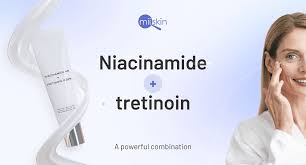
Can I use Niacinamide with Tretinoin?
Tretinoin and niacinamide are two ingredients that deliver impressive skin results. Although their names may suggest they are unusual ingredients they are in fact quite common in various skincare formulas. It’s no wonder many of you are wanting to use the two of them together in your daily skincare routine.
Now, you may be sat there wondering can I use niacinamide with tretinoin? The aim of today’s blog post is to answer this and other questions we have heard about niacinamide and tretinoin.
Can I use niacinamide while using tretinoin?
Yes, you certainly can! When using both skincare superstars many find the best way of benefitting from each ingredient is too alternate applying them to the skin. You can opt for using niacinamide in your morning routine leaving tretinoin for the evening.
This is considered the best way of using each ingredient with minimal unwanted side effects. Apply niacinamide after cleansing the skin, preferably whilst it is still slightly damp to enable the humectant benefits to lock water into the skin surface.
Tretinoin is a highly potent ingredient and is remarkable at reducing signs of ageing as well as combating breakouts. As effective as it is, it’s known for causing the skin to become more photosensitive to UV exposure. Using it in the evening and ensuring you apply a daily SPF of 30 and above will help to counteract any long-lasting skin damage. If you are wanting to know more about tretinoin you can check out our dedicated blogpost about its skin benefits.
If you are looking for one product that contains both ingredients, this may be slightly tricky. This is because tretinoin is a prescriptive ingredient making it difficult to find an over-the-counter product containing both ingredients that will be as effective on the skin. Remember, if you have any concerns with skincare ingredients you should consult with a doctor or dermatologist.
Can I use retinol and niacinamide?
Yes, using retinol and niacinamide together make an impressive skin duo. Ideally you should apply the niacinamide first to slightly damp skin. This will lock in extra moisture into the skin surface leaving it plumped and hydrated. You will also find that because the skin barrier contains the correct amount of water the retinol will absorb into the lower layers enabling it to get to work rapidly. By following niacinamide with retinol you will also find you are able to combat any potential dryness or irritation the potent form of vitamin A is known to cause.
Do I put moisturiser on before or after tretinoin?
Since moisturisers are applied towards the end of your skincare routine, you can expect to apply it after tretinoin. You may have heard about the skin rule that the order you apply your skincare products plays an important role at ensuring each formula can deliver results. The best order to apply your skincare products is by starting with the thinnest consistency and working your way towards the thickest.
What products should I not use with tretinoin?
There are a few products containing certain ingredients that should be avoided when using tretinoin. Here are the main three,
Astringents/ Toners
With tretinoin being a mixture of all-trans retinoic acids it has a habit of causing dryness to the skin. Therefore, it’s best to avoid using potent toner or astringent formulas as these will dry the skin out further. You’ll find that if your skin is stripped of all its sebum (the natural oil found on the skin) it will over produce sebum resulting in the skin suffering from flare-ups in acne and other breakouts.
Chemical Exfoliants
Many people confuse the effects of retinoids with the exfoliating benefits of chemical exfoliants known as AHAs/BHAs, such as glycolic acid and salicylic acid. These exfoliants tend to work on the outer surface of the skin sloughing away dead skin cells. Retinoids on the other hand speed up the natural cycle of skin cells. All of this will become too much for the skin and result in inflammation, flaking, rashes, irritation, and general discomfort for the face.
Benzoyl Peroxide
With benzoyl peroxide being one of the most potent skincare ingredients you’ll find it delivers similar results as tretinoin. This is a recipe for disaster as the two ingredients layered together will be too harsh on the skin rendering both ingredients useless on the skin.
Of course, there are a few more ingredients that need to have some careful consideration when using them with tretinoin. Always check with a medical professional before introducing anything to your daily skincare routine.
Can I use tretinoin every night?
Yes, technically you can use tretinoin every night, however with the varying potency of the formulas may become too harsh on the skin. Instead, why not opt for using your favourite tretinoin enriched product every other evening or as instructed on the label. Tretinoin can cause skin peeling and mild irritation, especially if you have recently introduced it, you’re your routine. This will ensure you’re reaping the rewards without drying out the skin.
Does niacinamide cause purging?
No, niacinamide is not known for causing purging to the skin. This is usually a side effect of other skin ingredients that either exfoliate the surface or increase the skin cell turnover. Seeing as niacinamide doesn’t perform like this on the skin you’ll find instead it leaves the skin feeling hydrated, comfortable, and glowing with health.
Having said that, there are a few rare cases of people having negative reactions to niacinamide so always ensure you keep a close eye on how your face looks and feels when applying it.
Does tretinoin have retinol in it?
Yes, tretinoin and retinol are very similar skincare ingredients. The main difference is that tretinoin is a high concentrate of pure retinoic acid, whereas retinol is a form of retinoid that is converted into retinoic acid. Both ingredients deliver the same results and are both found in skincare formulations, tretinoin however is found in prescriptive products only. You will need to introduce both ingredients slowly and in the correct way into your everyday skincare routine to avoid severe dryness and other side effects.
So, there you have the answers to some of the questions we have seen regarding niacinamide and tretinoin together. If you still have a question, come over to our Instagram page and give us a follow!


